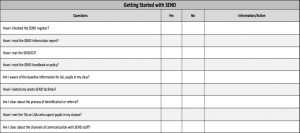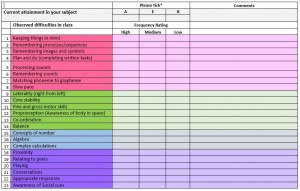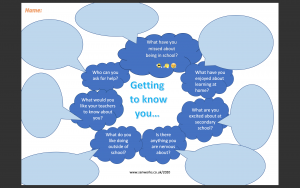NEW for 2023
The Effective Teaching Assistant Online Training Course
Preparing to support a pupil with SEND, at SEND support, means there is neither an EHCP to refer to and often no IEP. The information about their specific needs might be found on a school database but often it only contains a brief history of support and a snap shot of their difficulties. That’s why I have designed this editable and adaptable checklist to help teachers prepare to meet their needs. It sets out some key questions for both teachers and TAs, prompting them to record what works in their own classroom. This can then be passed on to new staff and at times of transition. Finding ways to avoid duplication and to learn from experience is essential if we are to provide effective support for these children as they change and progress.
A table in excel that invites SENDCOs to track their time over a typical week. Use it to capture the reality of your working week when reflecting on on workload and impact. Diaries or planners might not fully reflect the nature of your role, time management and priorities – or be fit for purpose when presenting your thoughts to colleagues.
You can personalise my list of suggested tasks as you see fit. You might change the value of a tally mark to a unit that suits you. I have set it to 30 minutes but you might prefer to use a lesson period or portion of a day. You can add comments or details as you wish.
I haven’t created the formula for adding up your hours, as I think the tally format is enough to show a pattern – but this is something you could add.
Whole staff induction for SENCOs – it is a format for you to populate with the info that is most important in your setting. Helping you start the year or the term by sharing the vital information for the whole staff team.
Updated Agenda for In-class support and TA Provision Audit
All Checklists from The Effective Teaching Assistant
These tables are taken from the new book for TAs, The Effective Teaching Assistant. I will be adding more videos to the new Youtube channel ‘Talking about SEND with Abigail’ over the coming weeks to explain at first hand how you might use them in training and practice. Links to the book can be found on this site.
ETA TABLES
Baselines
Click the link to download a checklist that supports teachers in taking a slightly more in depth look at the baselines available for their classes.
Returning to School
The planning and preparation involved in a full-scale return to school brings with it new challenges. Some pupils with SEND who have been in school will again be part of the larger group and those who have been learning at home will need to get back into the school routine. All change for everyone! Again. The research would suggest that planning for the transition, the baseline assessments that will take place and securing parental support and confidence requires good communication and transparency.
Here are 3 resources you can adapt and use to gather feedback from pupils with SEND and their parents, there is also a checklist for SENCOs to help prepare and organise.
With warm wishes to everyone for the next few weeks. You are doing an amazing job in hugely difficult circumstances.
In-class support Agenda NEW
Hot off the press, taken from The Effective Teaching Assistant (published December 2020) this is the tool to use when embarking upon supporting pupils in a new setting. Underpinned by the DR KEEPIT framework described in the book, working through this checklist with colleagues can ensure that both TAs and teachers are clear about roles and strategies for supporting vulnerable pupils and those with SEND.
Classroom routines checklist
Editable checklist of classroom routines. It can be used by TAs and teachers to support pupils with SEND who may struggle to follow the cues for everyday actives and transitions. It helps these pupils if expectations are clearly explained & actions practised. The language used for such instructions should be consistent.
Preparing to teach a pupil with an EHCP
Here is an editable checklist of considerations to make when preparing to teach or support pupil whose special educational needs are set out in an EHCP. It describes a pro-active approach that advocates making connections with and around the child. It’s not an exhaustive list but it’s a pretty robust start! Image below is just first 3 ideas out of 15.

Getting started with SEND checklist
Teachers – Here is a newly updated, editable resource for those new in post or new to teaching. It’s a checklist of things you can do to ensure that you hit the ground running when it comes to supporting children in your class with SEND.
SENCOs – You can use it as is or adapt it to support your existing role in induction. You might also find it helpful to use in collecting feedback from new or existing staff to check levels of engagement with key documents.

Teaching assistants, classroom support and social distancing…
Why should Teaching Assistants consider proximity to pupils?
While writing our new book, The Effective Teaching Assistant, Mel and I found ourselves exploring issues of proximity, the position in which TAs physically find themselves in relation to pupils in the classroom and the effect this has on the support they provide. We hardly knew at the time how much more complex this issue would become. On returning to school this September, in a post-COVID world, pupils are to be educated in ‘bubbles’ and social distance is to be a feature of every-day life. In writing, our focus was on pupil independence, we were thinking about proximity to promote independence in learning and social interaction – at the time we saw this as desirable, now of course it has become a necessity.
The guiding principal from the DFE on a safe return to school is that social distancing between staff and pupils should be maintained whenever possible. There is some acknowledgement that younger pupils and pupils with SEND and complex needs may prove to be an exception to this rule and in such cases support should be provided in ‘the normal way’.
However, anyone who spends time in the classroom will observe that TAs usually work in close proximity to pupils, with or without complex needs – quite literally alongside pupils in many cases. Their existing roles would certainly place them on the pupil’s side of the 2m divide as suggested in the new format, front facing classrooms.
There are obviously a number of ways to deal with this.
The SENCOs who most often orchestrate TA timetables may need to consider a new set of priorities; limiting the contexts in which the TA might work or creating new opportunities for TAs to work with pupils in smaller groups in break out spaces. It seems to me that even with bubbles and thoughtful timetabling a revised approach to the way in which support is offered in the classroom is going to be necessary.
So how can classroom-based support be effective for pupils in the current climate?
The model we describe in our new book requires teachers and TAs to work collaboratively to adapt teaching, supply accessible tasks and provide useful resources.
It is one in which TAs ‘check-in’ with pupils at regular intervals to offer specific support rather than remain close by to ‘oversee’ their learning. We have long observed that when TAs are in this fixed position, adjacent to the pupils they support, a number of issues can arise that hamper progress, impacting negatively on a pupil’s social interactions and even their attainment.
It is possible to be vigilant and supportive without being ever present and in this environment while maintaining a greater degree of social distance. Maybe we need to see TAs more as satellites than as CCTV cameras.
In turn, we examine how each of the following might feature in a helpful approach to in-class support for pupils with SEND and SpLDs. Dialogue, Resources, Key points, Encouragement, Engagement, Proximity, Identifying barriers and Task Chunking. We call this the DR KEEPIT agenda.
Whilst the book goes into some detail as to how these opportunities can be optimized in pupil/TA interactions, in response to the current crisis, we have done our best to create a revised list of helpful practices for TAs that might be achieved at an appropriate social distance. Today we start with Dialogue and Resources and think about the initial preparation for going back in to class.
Click on the red link below to download the checklists.
Dialogue and Resources considerations for TAs
Year 7 Transition
There has never been a transition quite like this for our new year 7s. Here is a ‘Getting to know you’ sheet that Mel and I have devised. Hope it helps to break the ice and get acquainted with the new pupils. Click on the red link to download.
Needs Matrix
I designed this as an editable checklist for classroom observations, it supports the identification of pupils’ barriers to learning. It can be used in a variety of ways to build a full picture of an individual’s strengths and weaknesses. Its uses are explained in detail in Chapter 3 of Effective Differentiation.

Pupil Passports
Simple pupil passport Click the red link to download a simple Pupil Passport. It records a process that includes the pupil and parents/carers.
SEND Information Reports
SEN IR checklist Click the red link to download.
This is the check list to use when compiling your SEND Information Report. For full details of inclusions go to P95 and 96 of the Code of Practice 2015.



